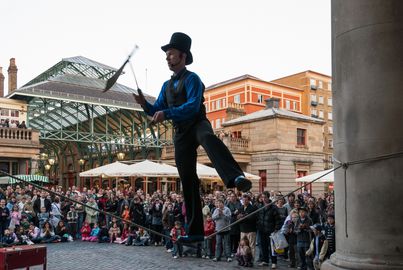

Here we are on the grand piazza of Covent Garden! Although Britons are not very fond of discussing the fact, their capital city of London was, in fact, founded by the Romans. There hadn't been anything here before. The city which the Romans founded was called 'Londinium', and was very much where the 'square mile' of what is properly called 'The City Of London' is now – in other words, the part of London where we now find the Tower of London and the banking district. Where we are now – to the West of 'Londinium' – was open fields, meadows and farms. However, the Roman city had to be fed and supplied, and outside its defensive walls, to the West, a settlement of locals, craftsmen, farmers and others grew up. When the Roman Empire crumbled, the new invaders, the Anglo-Saxons, built their 7th century fortress here on the site of that settlement, and named it Lundenwic. It wasn't the capital, however – that was in the city of Winchester. But Lundenwic fell into disuse as the ruins of the former Roman city were once again colonised, and Lundenwic was turned back into farmland. It remained so until the 16th century, when the orchards and gardens here were given to the monastic foundation of Westminster Abbey, and to a convent. It was the 'Convent's Garden', and thus the name 'Covent Garden' arose. After the monasteries and convents were dissolved by King Henry 8, their property was confiscated – the 'Convent Garden' was given to the Dukes of Bedford by King Henry. The Fourth Earl of Bedford began an ambitious plan to develop his land, from the 1620s onwards. He hope to build attractive housing for the rich, and obtained Royal permission to demolish slum housing to make way for this project – built for him by architect Inigo Jones. However, the Bedfords became greedy, and by 1654 they had decided to open a market on the open square they'd built – the noise and smell of the market quickly drove their rich tenants away, and the area instead became a place of coffee-houses and brothels. By 1756 prostitution had become the main business of the area, and there were even yearly catalogues - “Harris's List Of Covent Garden Ladies” - publishing names, addresses, prices and services on offer. Later editions even featured engravings of the ladies concerned. Covent Garden was so famed for the sex industry in the second half of the 18th century that prostitutes were referred to as “Covent Garden Ladies” even if they didn't live in Covent Garden, or even if they lived in a different city.
But the other pastime in 17th century and 18th century was theatre – and particularly musical theatre. Italian opera was so popular that it came under a Royal Monopoly – but this didn't mean it had to be written by Italians. In fact the monopoly on opera was held by a German – Georg Friedrich Haendel... or George Frederick Handel as he became after he moved full-time to London. But the public fell out of love with Handel, and he was forced to move from the King's Theatre (in Haymarket – the other side of where Trafalgar Square is now) to “a low, mean, wooden theatre near the vegetable market, well-known for crude pantomimes”. That theatre is now The Royal Opera House, Covent Garden, but its rise to fame and glamour was a slow one. In fact there has only been a full-time opera & ballet programme there since the middle of the 20th century.